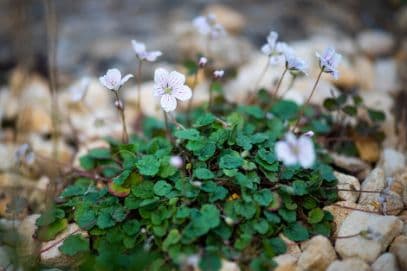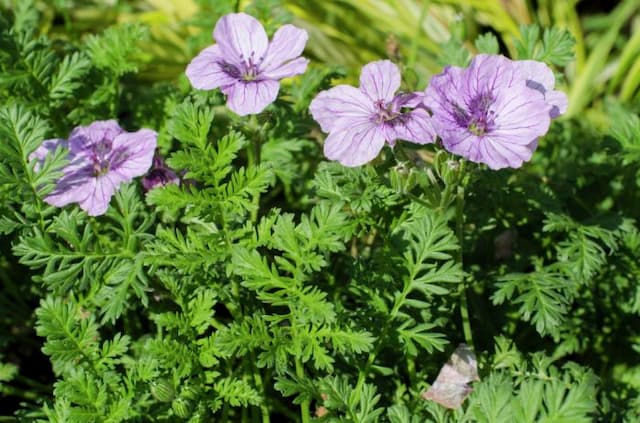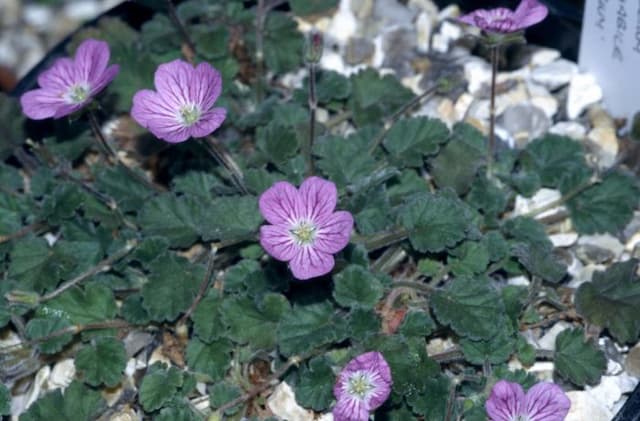Wlassov's Geranium Geranium wlassovianum 'Blue Star'

ABOUT
The Geranium wlassovianum 'Blue Star', commonly known as the hardy geranium or cranesbill, is a flowering perennial plant. This particular cultivar, 'Blue Star', is admired for its attractive foliage and eye-catching blooms. The leaves are uniquely textured, showcasing deeply lobed shapes with a somewhat fuzzy texture, imparting a soft, velvety appearance that adds lushness to the garden ambiance. During the changing seasons, the foliage offers a visual treat by turning into a beautiful autumnal color, providing year-round interest. The blossoms of 'Blue Star' emerge as striking blue flowers that are rounded and have a gentle, cup-like form. These flowers typically possess a delicate veining pattern in a slightly darker hue, which accentuates their shape and adds depth to their appearance. The plant blooms profusely, creating a dazzling display of these blue flowers that contrast nicely against the green backdrop of the leaves. The Geranium wlassovianum 'Blue Star' is a charming addition to garden spaces, from borders and beds to rockeries. Its appealing flowers and foliage, along with the lack of mention of its specific dimensions, allow it to integrate seamlessly into various garden designs, making it a versatile choice for gardeners looking to add a burst of color and texture to their outdoor sanctuary.
About this plant
 Names
NamesFamily
Geraniaceae
Synonyms
Wlassov's Cranesbill, Siberian Cranesbill
Common names
Geranium wlassovianum 'Blue Star'.
 Toxicity
ToxicityTo humans
Geranium wlassovianum 'Blue Star,' commonly known as Hardy Geranium, is not known to be toxic to humans. Most geraniums, including this variety, are generally considered non-toxic and do not typically pose a threat if ingested. There are no significant symptoms of poisoning associated with this plant since it is not considered poisonous to humans.
To pets
Hardy Geranium is also not known to be toxic to pets. It is generally considered safe for dogs and cats, and ingestion of this plant typically does not lead to poisoning. Therefore, pet owners do not need to be concerned about significant toxicity or symptoms associated with their pets ingesting parts of this plant.
 Characteristics
CharacteristicsLife cycle
Perennials
Foliage type
Deciduous
Color of leaves
Green
Flower color
Violet
Height
1-2 feet (30-60 cm)
Spread
1-2 feet (30-60 cm)
Plant type
Herb
Hardiness zones
4
Native area
Asia
Benefits
 General Benefits
General Benefits- Attracts Pollinators: Geranium 'Blue Star' is known for attracting bees and butterflies, aiding in the pollination of surrounding plants.
- Low Maintenance: It requires minimal care beyond occasional watering and trimming, making it ideal for busy gardeners.
- Drought Tolerant: Once established, it can withstand periods of low water, making it suitable for drier climates or water-wise gardens.
- Long Blooming: With a lengthy flowering period, it provides a prolonged display of color in the garden.
- Cold Hardy: It can survive in cooler climates, extending the range of regions where it can be grown.
- Erosion Control: The plant's root system helps stabilize soil and prevent erosion on slopes or in problem areas.
- Versatile Landscaping: It can be used in borders, rock gardens, or as ground cover, offering a range of landscaping possibilities.
- Aesthetic Appeal: The distinctive deep blue flowers add a splash of color to any garden palette.
 Medical Properties
Medical PropertiesThis plant is not used for medical purposes.
 Air-purifying Qualities
Air-purifying QualitiesThis plant is not specifically known for air purifying qualities.
 Other Uses
Other Uses- Geranium 'Blue Star' as a natural dye: The flowers and leaves of Geranium 'Blue Star' can be used to create a variety of natural dyes for fabrics, with shades depending on mordants used.
- Photography prop: The vibrant blue flowers of Geranium 'Blue Star' may serve as a beautiful backdrop or an aesthetic prop for macro and nature photography.
- Educational tool: Geranium 'Blue Star' can be used in schools or educational gardens to teach students about plant growth, pollination, and horticulture practices.
- Artistic inspiration: The unique shape and color of Geranium 'Blue Star' can inspire artists and be used as a subject for paintings, drawings, and even sculptures.
- Floral water: Petals of Geranium 'Blue Star' could potentially be used to make scented floral water for use in homemade cosmetics or room sprays.
- Garden design: Due to their mounding habit and attractive foliage, Geranium 'Blue Star' can be used in landscape design to create borders or as a ground cover.
- Companion planting: Geranium 'Blue Star' can be planted alongside vegetables and other flowers to encourage biodiversity and attract beneficial insects to the garden.
- Culinary decoration: Although not commonly used for consumption, the petals of Geranium 'Blue Star' could be used to decorate desserts and salads after ensuring they are free from pesticides and are safe to eat.
- Pressed flower crafts: The blossoms of Geranium 'Blue Star' can be pressed and preserved for use in crafting, such as making bookmarks, greeting cards, or decoupage projects.
- Wedding decor: The elegant appearance of Geranium 'Blue Star' makes it suitable for use in wedding bouquets, centerpieces, or as natural confetti.
Interesting Facts
 Feng Shui
Feng ShuiThe Geranium is not used in Feng Shui practice.
 Zodiac Sign Compitability
Zodiac Sign CompitabilityThe Geranium is not used in astrology practice.
 Plant Symbolism
Plant Symbolism- Unexpected Meeting: The Geranium, in general, is known to symbolize an unexpected encounter, as these plants can pop up in various places where they weren't intentionally planted.
- Friendship: Often geraniums are given as gifts to symbolize friendship and the strengthening of bonds between two people.
- Good Health: The vibrant and robust nature of geraniums is often associated with wishes for good health and vitality.
- Positive Emotions: The 'Blue Star' variety with its beautiful blue flowers can evoke feelings of peace and serenity, symbolizing tranquility.
- Fertility: In some cultures, geraniums are seen as a symbol of fertility and reproduction because of their prolific nature and ability to propagate efficiently.
 Water
WaterThe Wlassov's Geranium, commonly known as 'Blue Star', prefers consistently moist soil, so regular watering is important. Water the plant deeply when the top inch of soil feels dry to the touch, which typically means watering once or twice a week. During the hot summer months, you may need to increase watering frequency. Provide at least 16 ounces of water for smaller pots or up to 2 gallons for larger outdoor plantings each time you water, ensuring even soil moisture without waterlogging.
 Light
LightWlassov's Geranium thrives in a spot with full sun to partial shade. The ideal placement would ensure that it receives at least 4 to 6 hours of sunlight daily, with some protection from the intense afternoon sun in hotter climates to prevent leaf scorch.
 Temperature
Temperature'Blue Star' Geranium favors a temperate climate and can tolerate a range from about 50 to 75 degrees Fahrenheit. It can survive short periods of temperatures down to 20 degrees Fahrenheit and up to 80 degrees Fahrenheit, but the ideal range for robust growth would be between 60 to 70 degrees Fahrenheit.
 Pruning
PruningPrune Wlassov's Geranium in late winter or early spring to maintain its shape and promote healthy growth. Remove dead or damaged stems and spent flowers to encourage new blooms. Pruning can be done every year or every other year as needed to keep the plant tidy and vigorous.
 Cleaning
CleaningAs needed
 Soil
SoilThe Geranium wlassovianum 'Blue Star', also known as the Wlassov's Cranesbill, thrives in well-draining soil with a mixture of loam, peat, and sand, which allows good aeration and drainage. A slightly acidic to neutral pH balance, ranging from 5.8 to 7.2, is ideal for this plant. To enhance drainage and fertility, incorporate organic matter such as compost or well-rotted manure into the soil mix.
 Repotting
RepottingWlassov's Cranesbill should be repotted every 2 to 3 years to refresh the soil and accommodate root growth. The best time to repot is in early spring before the growing season, or in the fall after the plant has finished blooming.
 Humidity & Misting
Humidity & MistingWlassov's Cranesbill is adaptable to a wide range of humidity levels but prefers a moderate climate. It does not require high humidity to thrive and can tolerate the natural humidity found in most outdoor garden settings, making it a low-humidity tolerant plant.
 Suitable locations
Suitable locationsIndoor
Place in bright indirect light, ensure good airflow, water when topsoil is dry.
Outdoor
Plant in partial shade, protect from harsh sun, enrich soil, ensure drainage.
Hardiness zone
3-8 USDA
 Life cycle
Life cycleThe Blue Star Geranium, Geranium wlassovianum 'Blue Star', begins its life cycle when seeds germinate in late winter to early spring under appropriate temperature and moisture conditions. Seedlings emerge and establish a rosette of leaves, which will be followed by the development of a deep root system and the growth of upright flowering stems as temperatures rise. Throughout spring and early summer, the plant enters its vegetative growth phase, producing distinctive lobed leaves and branching stems that prepare it for the flowering stage. The Blue Star Geranium typically flowers in mid to late summer, showcasing its blue-violet flowers with contrasting dark veins and a white center. After pollination, often by insects, the plant sets seed in the form of a unique beak-like capsule that, once mature, can catapult seeds several meters away. As autumn approaches, the plant begins to die back, entering a period of dormancy during winter, wherein it stores energy in its roots for the next growing cycle.
 Propogation
PropogationPropogation time
Spring-Early Summer
Geranium wlassovianum 'Blue Star', commonly known as Geranium 'Blue Star', can be propagated through the division of the plant. The best time for division is either in the early spring as the plant emerges from dormancy or in the late fall as the plant goes dormant. To propagate by division, carefully dig up an established clump and gently separate the plant into smaller pieces, each with a section of root and several shoots. These pieces can be immediately replanted in the garden or into pots filled with potting mix. Ensure that each new plant has adequate soil coverage and is watered well after planting to facilitate the establishment in its new location.




![Cranesbill [Blue Sunrise]](/_next/image?url=https%3A%2F%2Fplants-admin.emdemapps.com%2Fimages%2Fplants%2F%2Fimages%2F604b638d45948.png&w=640&q=75)




